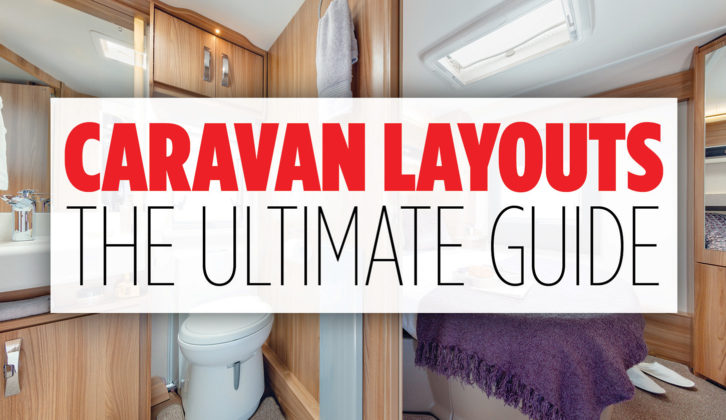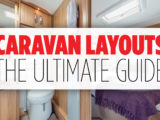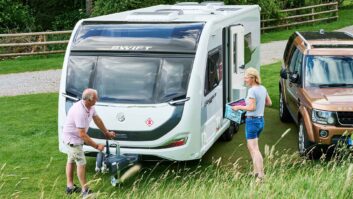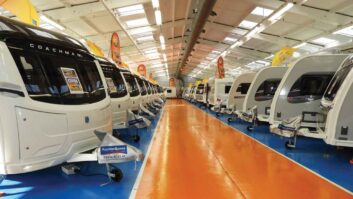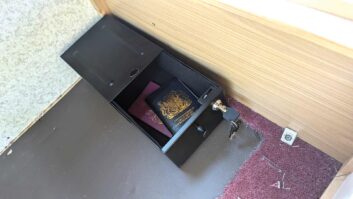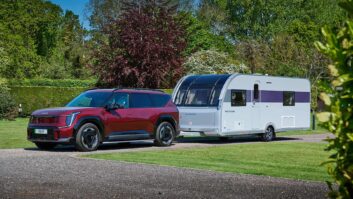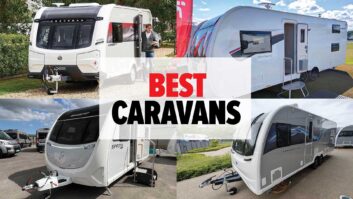One of the most crucial steps to identifying the best caravan for your travels will involve having a clear idea of the caravan layout you want.
Everyone will have their own requirements, and fundamentally, the arrangement you settle on will depend on what you and your companions want from a tourer. A good way to get an understanding of the different options is to visit a big show, where you’ll find the best caravan manufacturers showing their latest releases.
Another place you can head to is a dealership, although you may find they’re affiliated with a small number of brands. However, they could provide you with some useful suggestions you may not have otherwise thought of.
To help you with how to choose the right caravan, we’re taking a look at the most popular caravan layouts, who they are good for and who should avoid them…
How to choose the caravan layout for you
There are a wide range of caravan layouts to choose from, all with their own pros and cons. When you’re trying to settle on the arrangement that will suit you, there are some points to think about that can help you decide.
Firstly, what will you be using your new tourer for? If you’re only planning to use it for a couple of nights away at a time or as a useful base for fishing, you may be happy with a more basic tourer. However, if you intend to use it to enjoy a family holiday, a larger tourer with a fixed bed is likely to be a more appealing prospect.
Another consideration is where will you be going in it? Are you planning to tour around the UK’s best caravan parks, or are you looking to spend more time touring abroad? If the latter, a Continental model with a door on the Continental side makes sense. This means your van will be matched more easily with the infrastructure found on European caravan parks, and it would also make it easier to get out if you stop on the side of a road.
It’s also worth thinking about the type of sleeping arrangements that you would like to see. One of the more popular caravan layouts is an island bed in the rear, typically featuring a washroom behind it. This will also see a kitchen in the middle, before you reach the front lounge.
This is a popular choice because it gives a couple the option of using it mainly for themselves, while having the space for extra guests to stay for short periods of time.
However, it’s a caravan layout that may not work so well when you’re touring as a family. This scenario would see the parents want a double bed, but older children may not like only having the front lounge to call their own.
You should also factor in whether or not you will be cooking in your van. Caravan cooking is normally easier than it would be in a motorhome, as they’re normally larger, but dealers have told us before that they have taken a caravan in part-exchange and found the oven has never been used. However, one thing you will need is a mains socket, for the kettle and toaster in the morning.
We’d also recommend giving the washroom some thought. Even if you’re not using it on a regular basis, it provides you with a place for hanging wet coats to dry, or, weight/loading restrictions permitting, it can give you a useful place to dry an awning when it’s time to go home.
The most popular caravan layouts are…
1 Transverse island bed, rear washroom
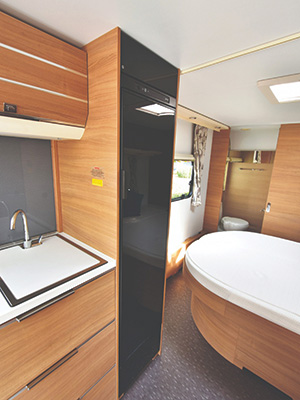
Island beds are a surprisingly recent addition to caravans, and were really introduced from the world of motorhomes.
Caravans are a bit wider than motorhomes, though, so it is far more common to see them with a transverse island bed, which takes up less overall length.
This floorplan, with an end washroom, is probably the most popular, particularly for those who tour as a couple, with only occasional guests.
You get a washroom more to yourselves, and the centre of the caravan feels more airy than it would if there were a central washroom spread over the axle.
That means less privacy than there would be with something dividing the caravan in half and, as with all island-bed layouts, you do have to make sure there’s enough room for a good-sized lounge up front.
Good for:
- Couples mainly travelling on their own
Less good for:
- Parties with small kids who might need to use the toilet at night
2 Transverse island bed, central washroom
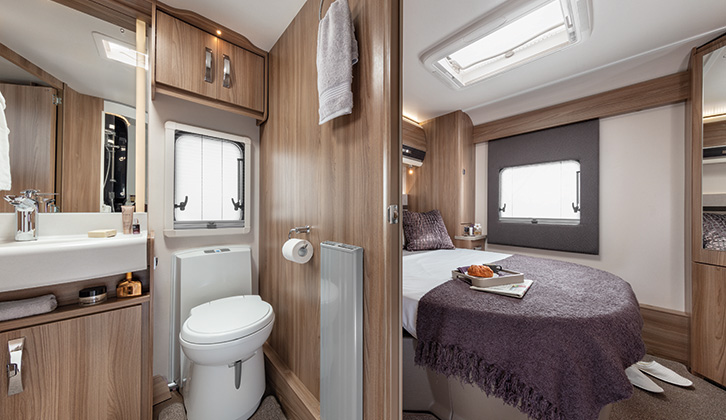
Transverse island-bed layouts with central washrooms are slightly less common than those with end washrooms. With that washroom usually spread right across the caravan, they do offer more privacy for whoever sleeps in the island bed. You can have a real den in here. Quite often the central washroom is partitioned off on both sides, giving you in effect a dressing room as well as a washing room.
But this arrangement can make the centre of the caravan feel dark and cramped, so some manufacturers still offer the option of having the washroom on only one side, with more of a gangway going right through the interior.
As with all permutations of the island-bed layout, make sure the one that you are interested in does have a suitably sizeable front lounge.
Good for:
- Family parties where the adults want some privacy
Less good for:
- Anyone wanting a really airy interior
3 In-line island bed, central washroom
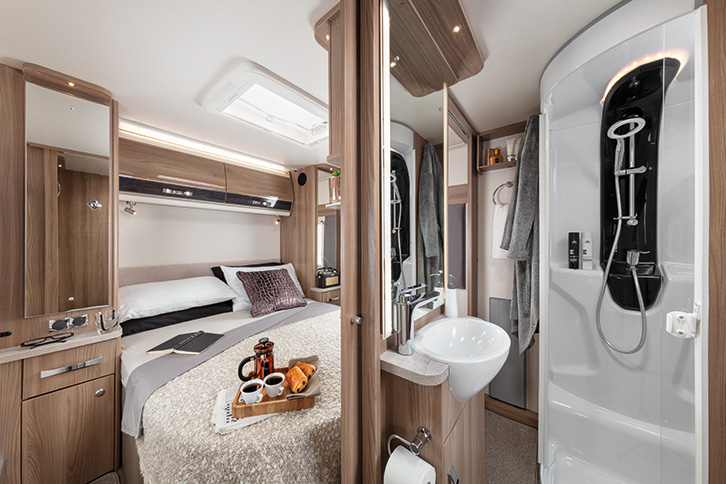
Some caravan layouts offer an in-line island bed – in other words, one that runs lengthways from the back of the tourer. For obvious reasons, these tend to be longer vans, often with twin axles.
These models usually have the washroom spread right across the width of the interior, with all that entails, and some have even copied another recent innovation from the world of motorhomes, where the basin is centrally located on the other side of a pillar at the foot of the bed.
In-line island beds tend to be easier to walk around, but one disadvantage in caravans is that the large storage area below them is usually only internally accessible. With a transverse bed, there is often an external access locker door on the side of the van, but you never see such a thing on the rear panel.
Good for:
- Confident towers who like a luxurious bedroom
Less good for:
- Anyone hoping to travel with bulkier items stored in the caravan
4 Single beds, end washroom
This arrangement can often look almost like two separate lounges, and in fact, with just a couple of additional scatter cushions, you could turn the single beds into extra seating during the day, although there won’t be a table here.
Having the washroom at the end of the caravan leaves the central area feeling much more roomy. There isn’t always any kind of partition separating off the bedroom area, however, and the end washroom is a fair way away at night-time for anyone sleeping in the front beds. There should be external access at least to the area under the nearside bed, if you want to store bulky items.
Good for:
People who like interiors to be airy, or prefer the toilet to be out of the way
Less good for:
Those travelling with small children who are liable to need the toilet at night. Also, it’s possibly less practical if you have a lot of heavy sports kit to take with you
5 Single beds, central washroom
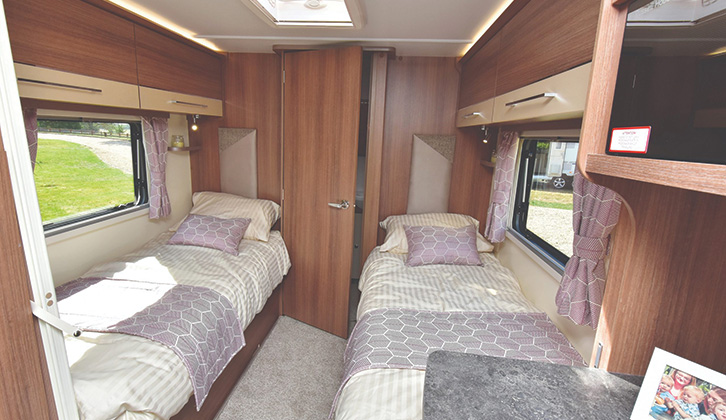
This layout, with a central washroom spread across the van and two single beds right behind it, is just about hanging on among UK manufacturers.
With nothing beyond the beds at the rear, the back bedroom can tend to feel cut off, so this layout is very good for anyone who likes to get away from potential noise up front. But you still have the same problems with the central area of the van being less airy and feeling more cramped.
Good for:
- Couples who want luxury but also their own sleeping space, or friends who are travelling together
Less good for:
- A sense of camaraderie on tour
6 Rear corner bed, corner washroom
Rear corner beds take up less length and space than island beds, and are almost as popular. With a corner washroom, as in this layout, you can introduce them into relatively short vans, because bed and washroom take up the same amount of length.
This layout is frequently found in caravans for larger families, where there is often more than one dinette as well. Adults get space, but not much privacy.
However, anyone who goes for this layout soon realises that there is the problem of having to clamber over your partner to get out of bed, and one of you having to sleep on the side of the double that is shorter. Corner washrooms are often quite poky, and there is usually a compromise where you have to pass the toilet to reach the shower, or vice versa.
Good for:
- Those who want a fixed bed in a shorter van, or larger families where the parents want some privacy
Less good for:
- People seeking a luxurious washroom
7 Corner bed, end washroom
Having an end washroom behind the rear corner bed gets over the problem of the washroom being poky, because they are often huge – although that does tend to make for a longer caravan overall.
Moving the washroom back often provides more wardrobe space, too, or a larger central dinette, and there’s sometimes extra storage on the way down to the washroom door.
But that washroom is a very long way away for anyone who is sleeping at the front to reach at night. There’s not much in the way of any partition for privacy, either. But there should usually be an exterior locker door to give you access to the area underneath the bed.
Good for:
- People who want the luxury of a large fixed double bed and a washroom on hand. Particularly good if there are usually just the two of you on tour
Less good for:
- Anyone who travels with kids who are liable to need the toilet at night
8 Rear lounge
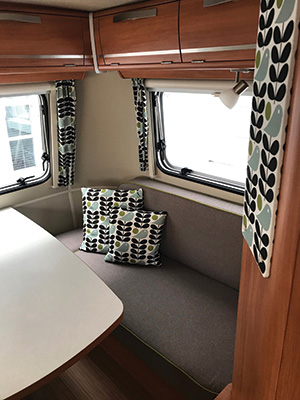
Caravans with two lounges – one at the front, one at the back – were once the mainstay of all tourer ranges. But they have almost entirely petered out now, thanks to the advent of fixed beds. There are still one or two on the market.
They probably make sense if you are a large group of relatively young, agile people who don’t mind dealing with slats and infill cushions every night. Or perhaps if there are just two of you and you want a smaller caravan for towing purposes, but you might also occasionally take a grandchild along with you. Or perhaps one of you stays up late or gets up particularly early.
Sometimes, if there are just two of you, it can be appealing to leave the bed in front made up and just use the little lounge at the rear during the day.
Good for:
- Large families, or couples with an early riser or who occasionally bring a grandchild along with them
Less good for:
- Anyone who finds putting up beds a chore
9 End washroom
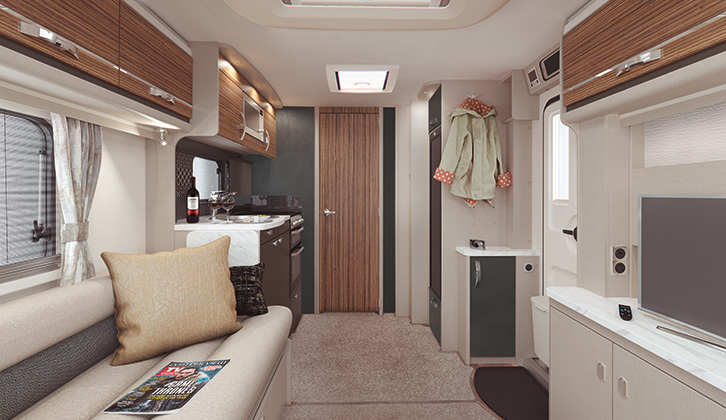
This caravan layout, with a large and usually luxurious end washroom at the rear, has become increasingly popular in recent years, particularly in two-berth caravans.
It can provide a very comfy experience – as long as you don’t mind making up the bed – because moving the washroom to the back usually leaves enough space on the nearside rear for a large sideboard, providing extra storage and a place to put the TV. Although this layout is most common in two-berths, there are some vans on the market that include a side dinette here, which can be converted into a single bed or a pair of bunks.
Of course, you don’t get the sideboard in this arrangement.
Good for:
- Couples who usually tour by themselves and still want to have some home luxuries
Less good for:
- Anyone who finds making up beds a chore, or who might travel with an extra guest for a longer period of time
10 End kitchen
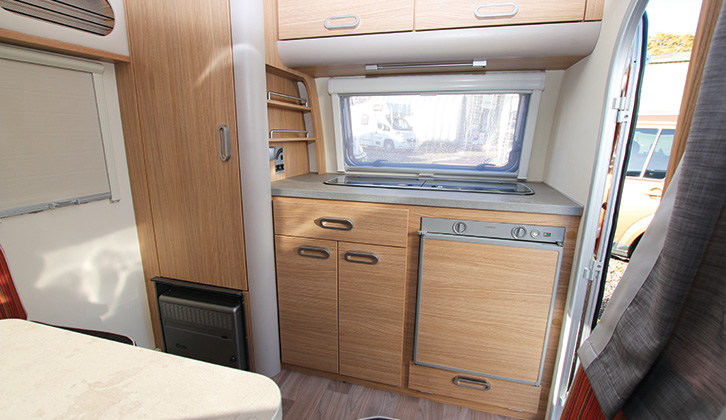
If you think the stricter confines of a caravan should not prevent you from rustling up a quick cassoulet, then this layout, with the kitchen spread most of the way across the back of the interior, could be just the right one for you.
The kitchen in this floorplan is usually L-shaped, which is excellent for ergonomics, has loads of storage space, and tends to get much better light than it would if it were on the side, because the van usually includes a large rear window.
You do, however, have to make some sacrifices as a result. The washroom in this floorplan is often squashed into the corner, so can be poky. And this layout is currently only available in new caravans as a two-berth, so you have to be sure you will only ever tour as a couple.
Some Continental models had the kitchen across the front, but this proved unpopular in the UK.
Good for:
- Chefs in the caravan
Less good for:
- People who think that a comfortable washroom is more important
Bunk bed arrangements
Fixed bunk beds are a regular feature in UK and Continental caravans – unlike in motorhomes, where in the UK at least they are pretty much invisible. If you are taking a large party with you on tour, you have a choice of three, possibly four, layouts.
11 Lateral bunks, corner washroom
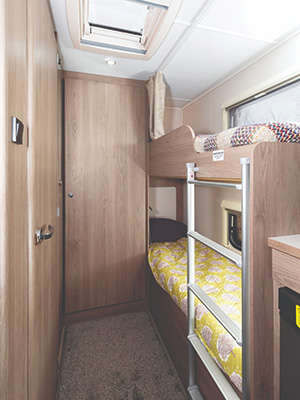
Possibly the most popular option, here you have a pair of bunks in one rear corner and a corner washroom in the other, with the two usually separated by a large wardrobe.
In longer caravans, having so much at the rear does mean you have extra space further up front for a second dinette, which can sometimes be made into bunks, or a bed for a child, and a larger central kitchen.
But there is not much privacy, even with curtain partitions, and you do have to sneak past quite a few sleeping bodies to reach the toilet at night.
Good for:
- Larger families with kids of widely differing ages
Not good for:
- Anyone who values privacy above all
12 Children’s room
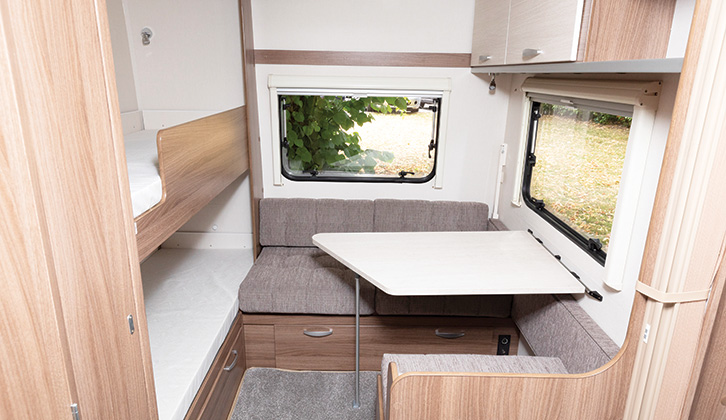
This layout, with a pair of bunks in the rear offside corner next to a small dinette that can be turned into two more bunks, has rapidly gained in popularity.
The children get an area they can call their own, and not just at night-time.
You can have this floorplan with a central kitchen opposite a central washroom, which is fine if you are content for the adults and the children to be a fair way apart.
But if you have the room and resources for a larger caravan, there are models available with the washroom spread across the centre, and partitioned off.
That way you can put the kids to bed earlier in the evening, and everyone still has good access to the toilet.
Good for:
- Adults and children who like to have some space of their own
Less good for:
- Anyone who prefers to be together, or feels that the adults should have a fixed bed
13 Lateral bunks, end washroom
As with rear corner beds, this is another option that is popuar, with the washroom spread right across the rear of the van.
This arrangement means you have a bigger washroom, which can sometimes be pushed right to the back to provide room for a second dinette (and maybe even a second set of bunks) directly opposite the fixed bunks.
This type of floorplan gives you a children’s zone, which you could potentially partition off. However, an issue with it is you still have to get past this area to use the washroom at night.
Good for:
- Families who need a large washroom, or where the kids want to be together
Less good for:
- Adults who want easy washroom access
14 Transverse bunks
While this arrangement, which sees bunks spread across the back of the caravan, has disappeared from UK ranges, it is still offered by some Continental brands.
It allows you to get a large number of people into a relatively short van, because the bunks take up much less length than they would if they were lateral. Some firms offer three bunks here, so you could tour with five, or even seven, people.
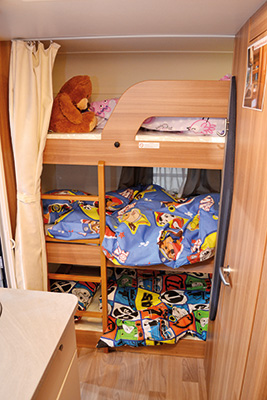
You do have to fit the kitchen and washroom in between the bunks and the front lounge, so there often isn’t room for a second dinette, unless you go for a huge van. That might be why this layout has proved less popular in the UK, with its unpredictable weather.
The two sleeping areas are quite far apart, but you might think that is good for privacy.
Transverse bunks are more easily partitioned off with a straight curtain.
Good for:
- Large families in smaller caravans
Less good for:
- Families who spread out during the day
If you liked this, why not read these?
- Our guide to the best used tow cars could help you find the ideal pre-owned towing vehicle to suit your needs.
- We take a look at 10 questions to consider to help you choose the caravan for you
- We round-up the exterior checks to look at if you’re thinking of buying a pre-owned tourer
If you’ve enjoyed reading this article, why not get the latest news, reviews and features delivered direct to your door or inbox every month. Take advantage of our brilliant Practical Caravan magazine SUBSCRIBERS’ OFFER and SIGN UP TO OUR NEWSLETTER for regular weekly updates on all things caravan related.
